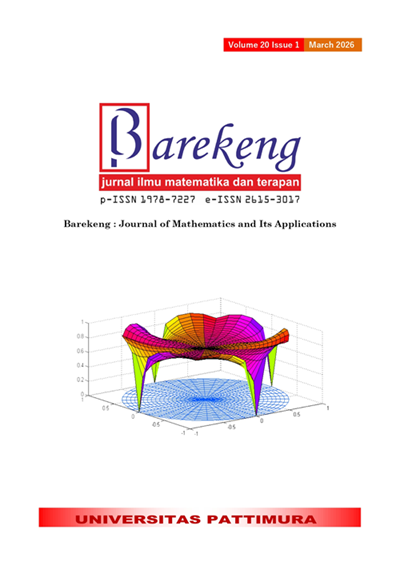FLOOD REINSURANCE PREMIUM PRICING BASED ON THE STANDARD DEVIATION PRINCIPLE WITH POT-BASED THRESHOLDS FOR MORTALITY AND PROPERTY DAMAGE RISKS
Abstract
Disasters that occur in Indonesia lead to financial loss. One approach to mitigating the financial impact is through the utilization of natural disaster insurance. Although natural disasters occur with a relatively small frequency, the associated losses are substantial. Insurance companies need to carefully consider the characteristics of natural disaster data, as these events can lead to significant claims and potentially result in the bankruptcy of insurance companies. Insurance companies can reduce the risk of bankruptcy by transferring some risk to reinsurance companies. In this paper, the disaster reinsurance premium is determined by considering both the mortality and economic risks using the peaks over threshold (POT) model under the standard deviation principle. The Poisson, generalized Pareto, and lognormal distributions are used to determine the premium, with parameters estimated using the maximum likelihood method. A simulation analysis is conducted using synthetic data generated with RStudio software, which includes the frequency of floods per year over 20 years, as well as the number of deaths and the number of houses damaged in each flood event. The threshold is determined using the percentage method, where 10% of the data is considered extreme values. The POT model is applied to various retention cases. The simulation results show that the risk of the number of damaged houses has a greater impact on the premium amount that the insurance company must pay to the reinsurance company than the risk of the number of deaths. Additionally, cases with retention values below the threshold result in the highest reinsurance premiums, while cases with retention values above the threshold result in the lowest reinsurance premiums. This paper also shows that the reinsurance premium changes almost linearly with the increase in the extreme value percentage. This study is among the first to apply the peaks over threshold model in combination with multiple distributions for reinsurance premium estimation in the Indonesian context. The findings provide new insights into the sensitivity of reinsurance premiums to damage thresholds and retention levels, offering a practical tool for insurers in disaster-prone regions.
Downloads
References
I. Hasbiyati, M. Abdullah, R. Salambue, and A. Ahriyati, “NORTHWEST CORNER METHOD FOR NATURAL DISASTER NOTIFICATION,” Barekeng: Jurnal Ilmu Matematika dan Terapan, vol. 16, no. 1, pp. 271-280, Mar. 2022. https://doi.org/10.30598/barekengvol16iss1pp269-278
Z. Qonita, S. Karima, A. Rusdiansyah, and R. Riyandari, “NUMERICAL MODELING OF THE 1998 PAPUA NEW GUINEA TSUNAMI USING THE COMCOT,” Barekeng: Jurnal Ilmu Matematika dan Terapan, vol. 18, no. 1, pp. 349-360, Mar. 2024. https://doi.org/10.30598/barekengvol18iss1pp0349-0360
Y. Hikmah, “LOGISTIC MODELING TO PREDICT THE INTEREST OF THE INDONESIAN PEOPLE FOR BUYING FLOOD IMPACTED INSURANCE PRODUCTS,” Barekeng: Jurnal Ilmu Matematika dan Terapan, vol. 17, no. 1, pp. 323-330, Apr. 2023. https://doi.org/10.30598/barekengvol17iss1pp0323-0330
D. L. A. Primananda and M. Muhajir, “MODELLING EARTHQUAKE DISASTER DAMAGE DUE DEPTH OF EPICENTER AND MAGNITUDE USING SPATIAL REGRESSION,” Barekeng: Jurnal Ilmu Matematika dan Terapan, vol. 17, no. 3, pp. 1221-1234, Sep. 2023. https://doi.org/10.30598/barekengvol17iss3pp1221-1234
A.S. Jalandri, S. Nurrohmah, and I. Fithriani, “PRICING CATASTROPHE REINSURANCE RISK PREMIUM USING PEAKS OVER THRESHOLD (POT) MODEL,” Physics, vol. 1, no. 1, pp. 1742-6596, 2021. https://doi.org/10.1088/1742-6596/1725/1/012086
W. Chao, “PRICING CATASTROPHE REINSURANCE UNDER THE STANDARD DEVIATION PREMIUM PRINCIPLE,” AIMS Math, vol. 7, pp. 4472-4484, 2022. https://doi.org/10.3934/math.2022249
P. Strickler, “R¨UCKVERSICHERUNG DES KUMULRISIKOS IN DER LEBENSVERSICHERUNG,” XVI International Congress of Actuaries in Brussels, 1, pp. 666–679, 1960.
H. Q. Xiao and S. W. Meng, “EVT AND ITS APPLICATION TO PRICING OF CATASTROPHE REINSURANCE (IN CHINESE),” J. Appl. Stat. Manage., vol. 32, pp. 240–246, 2013. http://dx.doi.org/http://dx.doi.org/10.13860/j.cnki.sltj.2013.02.003
M. Leppisaari, “MODELING CATASTROPHIC DEATHS USING EVT WITH A MICROSIMULATION APPROACH TO REINSURANCE PRICING,” Scandinavian Actuarial Journal, vol. 2016, pp. 113–145, 2014. https://doi.org/10.1080/03461238.2014.910833
E. Ekheden, and O. Hössjer, “PRICING CATASTROPHE RISK IN LIFE (RE)INSURANCE,” Scandinavian Actuarial Journal, vol. 2014, pp. 352–367, 2014. https://doi.org/10.1080/03461238.2012.695747
H.A. Surya, H. Napitupulu, and Sukono, “DOUBLE RISK CATASTROPHE REINSURANCE PREMIUM BASED ON HOUSES DAMAGED AND DEATHS,” Mathematics, vol. 11, pp. 810, 2023. https://doi.org/10.3390/math11040810
R.V. Hogg, J.W. McKean, and A.T. Craig, INTRODUCTION TO MATHEMATICAL STATISTICS, 8th edition, Boston:Pearson, 2019.
S.A. Klugman, H. H. Panjer, and G.E. Willmot, LOSS MODELS: FROM DATA TO DECISIONS, 5th edition, Hoboken:Wiley, 2019.
J. Beirlant, Y. Goegebeur, J. Teugels, and J. Segers, STATISTICS OF EXTREMES: THEORY AND APPLICATIONS, John Wiley & Sons, Ltd, 2005. https://doi.org/10.1002/0470012382
A.A. Balkema, and L. De Haan, “RESIDUAL LIFE TIME AT GREAT AGE. ANNALS OF PROBABILITY,” The Annals of Probability, vol. 2, pp. 792–804. https://doi.org/10.1214/aop/1176996548
J. Pickands III, “STATISTICAL INFERENCE USING EXTREME ORDER STATISTICS,” The Annals of Probability, vol. 3, pp. 119–131, 1975. https://doi.org/10.1214/aos/1176343003
J. Liu, and Y. Li, “EMPIRICAL STUDY ON EARTHQUAKE LOSSES DISTRIBUTION AND CAT BOND PRICING IN CHINA,” Finance Trade Res., vol. 20, pp. 82–88.
V. Pisarenko and M Rodkin, HEAVY-TAILED DISTRIBUTIONS IN DISASTER ANALYSIS. Springer, 2010.
https://doi.org/10.1007/978-90-481-9171-0
K. Burnecki, A. Misiorek, and R. Weron, STATISTICAL TOOLS FOR FINANCE AND INSURANCE, Springer Verlag, 2005.
https://doi.org/10.1007/3-540-27395-6_13
P. Maneerat, S-A. Niwitpong, and S. Niwitpong, “SIMULTANEOUS CONFIDENCE INTERVALS FOR ALL PAIRWISE COMPARISONS OF THE MEANS OF DELTA-LOGNORMAL DISTRIBUTIONS WITH APPLICATION TO RAINFALL DATA,” PLOS ONE, vol. 16, no. 7, pp. 1-25, 2021. https://doi.org/10.1371/journal.pone.0253935
Badan Nasional Penanggulangan Bencana (BNPB), DIBI. [Online]. available: https://dibi.bnpb.go.id/ [Accessed: 30 January 2025].
P. Embrechts, C. Klüppelberg, and T. Mikosch, MODELLING EXTREMAL EVENTS. Cambridge University Press, 2014. https://doi.org/10.2143/AST.28.2.519071
Copyright (c) 2025 Vanessa Anggriawan, Ferry Jaya Permana, Benny Yong

This work is licensed under a Creative Commons Attribution-ShareAlike 4.0 International License.
Authors who publish with this Journal agree to the following terms:
- Author retain copyright and grant the journal right of first publication with the work simultaneously licensed under a creative commons attribution license that allow others to share the work within an acknowledgement of the work’s authorship and initial publication of this journal.
- Authors are able to enter into separate, additional contractual arrangement for the non-exclusive distribution of the journal’s published version of the work (e.g. acknowledgement of its initial publication in this journal).
- Authors are permitted and encouraged to post their work online (e.g. in institutional repositories or on their websites) prior to and during the submission process, as it can lead to productive exchanges, as well as earlier and greater citation of published works.






1.gif)



